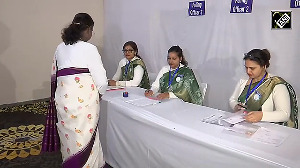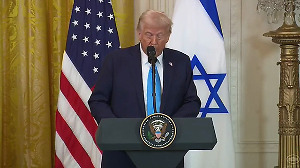If you're an Internet surfer, a new world awaits you. At your fingertips will be inter active television (you'll be able to change the story line of television programmes at will).
You can instal webcams at home to help you keep tabs on what your children are doing while you're in office. And if you're not yet a surfer at home because you don't have a personal computer, fret not -- you'll be able to buy a PC at rock bottom prices.
All this and more will be the outcome of the coming broadband revolution. Last fortnight, the state-owned Mahanagar Telephone Nigam Ltd and Bharat Sanchar Nigam Ltd announced broadband tariffs that are as low as Rs 399 a month, virtually half of what subscribers pay today.
BSNL, MTNL broadband service from Jan 14
So what does this mean for you as a broadband service subscriber? Precisely what broadband services can you expect and what broadband technologies exist here and overseas? We offer some jargon-free answers to these and other questions.
Does broadband mean only that you'll get access to the Internet at high speeds? What other services can you expect to get with a broadband connection?
You had an important meeting and so couldn't see your favourite television programme. Or when you were watching TV someone telephoned you and you missed parts of the programme. Or you'd like to fast forward a boring movie to see the ending.
Indeed, you'll be able to do all this if your television set is connected to a broadband network, something your cablewallah next door can't offer you.
All you need is a set top box which makes it possible for you to pause, rewind, fast forward and start live TV programmes and see them whenever you want to. By pressing a few buttons, you can also watch programmes that you have missed in the last few days without having to ask someone to pre record them.
Broadband offers: What's in it for you
Your television set will become an information and entertainment hub. You'll be able to subscribe to an array of other services -- video on demand and pay per view (you'll be able to see a movie by punching a few buttons), apart from interactive TV. Nor will you have to phone in or send an SMS to vote for your favourite singer on Sony TV's "Indian Idol." Instead, you can pick up your remote button, say "yes" or "no" to the choices offered on your TV screen by pressing a button.
Several kind of set top boxes will be available -- some will offer broadcast TV facilities (that is, you'll be able to watch TV without a cable connection), others will have encoders that make webcam surveillance possible.
Companies like UT Starcom are already hawking set top boxes (at around $100 to $150, or almost Rs 4,400 and about Rs 6,200) to telecom companies like BSNL (which used them on a trial basis), MTNL and Bharti Tele-Ventures. BSNL officials promise to offer a heap of value added services once the launch of broadband services in 198 cities stabilises.
To be sure, many telecom companies are already offering subscribers innovative solutions. The Tata-run Videsh Sanchar Nigam Ltd, for instance, allows subscribers to its broadband services a unique facility: they're given an ID and they can log on to their broadband account from anywhere in the country, provided the place from which they're accessing their account is also a VSNL broadband service subscriber.
Reliance Infocomm is using its Web Worlds to offer time to companies for video conferencing, at about Rs 2,000 an hour. Reliance Infocomm also offers an audio conference service (users are given a single number and password and can talk to one another from various locations without having to pay STD bills -- the call is a local call) at a monthly fixed rate.
If I don't want to invest in a complete PC, can I still get a broadband connection without spending too much upfront?
Yes, you can. Chipmaker AMD has tied up with VSNL to offer a "personal internet communicator". Powered by the Windows operating system, the small device attached to a monitor offers Internet browsing, instant messaging, spread sheet, PDF and word processor functions as well as Windows Media Player.
It also comes with a USB keyboard and a mouse and you can connect it to a printer too. It has a hard disk drive with 10 GB storage space. VSNL says that the box and the monitor are available for Rs 12,000 to Rs 13,000. The product has already been test launched in Chennai and will be tried out in Pune.
Says Shashi Kalathil, head of VSNL's broadband business: "We are working on various technologies to bring down the upfront cost of getting a broadband connection. The ideal levels would be Rs 7,000 to Rs 7500."
AMD has pointed out in a presentation that India has over 20.5 million households with an annual income of over $ 1,000 (almost Rs 44,000). But only 4.2 million households have a PC. So the PIC would make sense for 16.3 million households.
For those who don't have a PC, other options too like Microsoft MSN TV 2 will be available. Thomson RCA (which has tied up with Microsoft) offers a small set top box, which can be attached to a TV (since it does not need a separate monitor, you will save on costs).
Using this, you'll be able to access the Internet, view and share photos, play video games, open some common e-mail attachments and do instant messaging.
Navigation on TV is either through a keyboard or a remote control. A set up guide will help you here. But MSN TV 2 has no hard drive and storage capacity is limited. The price overseas is $200 (close to Rs 8,800).
TV 2 might soon be on its way to India. Admits Sanjiv Kainth, who heads Thomson's set top box business in India: "Yes, we are already talking to various people to launch the product in India."
What broadband technologies can you opt for?
Companies broadly offer two broadband solutions: wireless and wired fixed broadband.
In wired broadband, the most popular is the digital subscriber line route. MTNL, BSNL and companies like Bharti Tele-Ventures use the same telephone copper line that comes to your home (the last mile) for your fixed line phone to offer broadband services.
Some companies like Reliance Infocomm, however, are considering using optic fibre lines instead of copper lines. Optic fibre lines are no longer prohibitively expensive. Three factors have made them attractive.
Explains UT Starcom CEO Ruchir Godura: "Prices of fibre have crashed and have become virtually similar to those of copper. The price of electronic transmission equipment (required for optic fibre lines, both at home and at the telecom company's end) has dropped to $100-150. With new technology the same fibre can now be tapped to offer broadband services to 30-60 homes. So the cost of fibre lines gets spread over more customers."
More importantly, an optic fibre line can offer speeds of up to one gigabits and support many services that require large bandwidth. So you can get download speeds that are 25 times faster than those offered by a DSL connection. As a result, if high definition TV is ever introduced in India, the infrastructure won't have to be upgraded.
What wireless broadband solutions are being offered?
If you are on the move and want your laptop to be always connected to the Internet while you rush from one meeting to the next and if you are moving around in a car, you need broadband wireless services. You'll also need a wireless connection if you want your PC at home to be connected to the Internet without all these messy wires all over the place.
You have a lot to choose from. Worldwide Interoperability for Microwave Access, for example. Wi-Max offers a wireless alternative to the last copper mile needed in a DSL connection.
With a practical range of about 8 km, you could be on the move at home or within your neighbourhood and remain connected to the Internet. However, Wi-Max may not be commercially launched till 2006-2007 as the equipment is still being standardised.
Another option is time division code division multiple access, which is already up and running -- and will soon be in India. According to Godura, UT Starcom is in the final stages of signing a deal with a leading telecom company to offer TD-CDMA services to subscribers.
TD-CDMA does three things. First, it makes it possible for a PC at home to be connected to the Internet wirelessly without a last mile copper connection.
Secondly, you can buy a PC card and attach it to your laptop and move all over town connected to the Internet. The modem and the PC card will set you back by the equivalent of under $200.
For telecom companies, TD-CDMA is a viable option, especially for global system for mobile service companies which don't have fixed line telephone operations but still want to offer broadband services without having to invest in the expensive laying of copper lines.
GSM mobile service companies can use their existing infrastructure (base station towers and exchanges) to offer broadband services at an incremental cost.
Also, spectrum is scarce and most GSM service companies prefer to use a larger part of the frequencies allocated in GSM for voice services, which is still their core business, instead of for data services. But spectrum for TD-CDMA is easily available.
Yes, DSL is still cheaper than TD-CDMA, especially for incumbent telecom companies that already have copper connections to homes (the per subscriber cost for DSL is $ 100-150 or Rs 4,400 to Rs 6,200, versus $ 300 for TD-CDMA). But if a GSM company has to lay a copper line, TD-CDMA is cheaper.
Will you be able to access a broadband connection by using a mobile phone?
The answer is yes. You will soon be able to download a song on your mobile phone for a few seconds or see a TV channel programme streamed live. The GSM mobile phones that you use now offer you about 14 kbps speeds.
But the new Enhanced Data for GSM Environments (Edge) phones and services are already offering customers speeds that are five times faster than what a simple GSM service offers.
Hutchison Essar executives say that Edge services are catching on faster than general packet radio switching services because handset prices have tumbled. Hutchison Essar offers an Edge phone for a very affordable Rs 10,000.
It also offers Edge PC cards that can be attached to a laptop. Company executives say that Edge speeds are attractive because Edge connections are used for reading and sending e-mail. Hutchison Essar charges a rental of Rs 99 a month and has logged average revenues per user of around Rs 500 a month from data usage.
Those who want even higher speeds can look at subscribing to evolution data only services. In CDMA, companies like Reliance Infocomm are expected to launch EVDO phones. EVDO services will come at speeds that are 20 times higher than those offered by existing CDMA services.
GSM service companies too have applied for 3G spectrum. Many of them are expected to start trial runs by the end of this year. So you could soon have phones on which you'll get services at speeds that are now only available on a fixed line DSL broadband connection.
Plug in, for a connection
-
Laying cables to offer broadband services is expensive, especially if it's in rural India. But broadband service providers can look at another option: using the existing power lines to transfer data to subscribers. Quite simply, homes can plug in for a broadband connection, like they do for electricity.
-
By bundling radio frequency energy on the same electricity line with electric current, data can be transmitted, without a separate data line.
-
This is possible because the electric current and the radio frequency for data vibrate on different frequencies and do not interfere with each other. US companies like Enikia and Current Communications are already working with utility companies to turn this into reality.
-
Power companies have lines strung all over the world. There are more power lines than phone lines and their fibre backbone. This makes power lines an obvious vehicle for providing Internet services to places where fibre optic lines haven't been laid.
- Yet electricity moves through high voltage power lines. The power on high voltage lines is noisy. So companies are looking at alternative solutions, including transmitting data on lower voltage transmission lines. The last mile can be connected either wirelessly or by using the cable used to bring electricity to homes.







 © 2025
© 2025